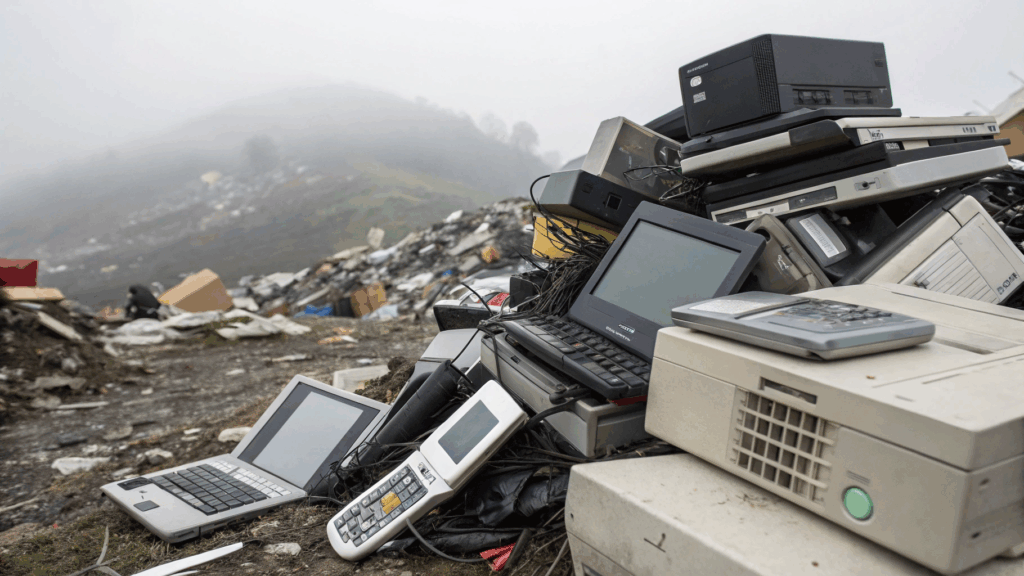The Environmental Footprint of Traditional Gadgets
Before diving into sustainable alternatives, it’s crucial to understand the environmental cost of traditional technology. The lifecycle of a typical gadget—from raw material extraction to production, transportation, use, and disposal—has a significant environmental footprint.

1. E-Waste Crisis
According to the Global E-Waste Monitor, over 62 million metric tons of e-waste were generated globally in 2022 alone, and only about 17% was formally recycled. The rest often ends up in landfills or is processed in informal and hazardous ways, releasing toxic substances like lead, mercury, and brominated flame retardants into the environment.
2. Carbon Emissions
Most gadgets are energy-intensive to produce. For instance, the production of a smartphone emits roughly 70–100 kg of CO₂, primarily during mining and manufacturing. As billions of smartphones, tablets, laptops, and smart home devices are sold each year, the carbon impact is enormous.
3. Resource Depletion
Electronics rely on precious and rare earth metals like cobalt, lithium, and tantalum. Mining these materials often causes deforestation, water contamination, and human rights abuses in developing nations.
These concerns have prompted consumers, tech companies, and policymakers to push for greener alternatives.
The Shift Towards Sustainable Gadgets
Sustainable gadgets aim to reduce these environmental impacts through better design, innovative materials, and ethical production. The shift isn’t just a moral imperative—it’s becoming a business and consumer demand.
1. Material Innovation
Eco-friendly gadgets often use materials like:
- Recycled plastics: Diverting waste from oceans and landfills.
- Bamboo and cork: Renewable, biodegradable, and stylish.
- Aluminum: Durable and infinitely recyclable.
- Bioplastics: Made from plant-based sources like corn or sugarcane.
2. Energy Efficiency
Modern devices now come with energy-saving features. Certifications such as ENERGY STAR help consumers identify products that use less electricity during use and standby.
3. Modularity and Repairability
Companies like Fairphone and Framework are designing modular smartphones and laptops, allowing users to repair or upgrade specific parts instead of replacing entire devices.
4. Recycling and Circular Economy
Sustainable tech embraces the concept of a circular economy—designing products with end-of-life in mind. That includes:
- Easy disassembly for recycling
- Trade-in programs
- Refurbished device markets
Examples of Sustainable Gadgets

The eco-friendly tech movement is already producing standout examples that combine functionality with sustainability.
1. Fairphone
The Fairphone is a modular smartphone built with conflict-free minerals and recycled materials. It’s designed for easy repair and long-term use, countering the throwaway culture of conventional smartphones.
2. Framework Laptop
This is one of the first truly modular laptops, allowing users to swap out almost every part—including the motherboard, battery, and ports. It’s a revolution in the world of fast-depreciating laptops.
3. Solar-Powered Tech
Gadgets powered by solar energy, like Goal Zero’s solar panels and power banks, offer renewable energy options for off-grid use. Even solar-powered e-readers and outdoor lights are gaining popularity.
4. Sustainable Wearables
Brands like Garmin and Apple are incorporating recycled materials in their smartwatches. Some models also use solar charging or energy-harvesting tech to minimize the need for constant charging.
5. Eco Speakers and Headphones
House of Marley produces audio devices using sustainable materials like bamboo, recycled aluminum, and FSC-certified wood, while also promoting plastic-free packaging.
The Role of Big Tech Companies
While small startups are leading innovation in eco-friendly gadgets, major tech players are also stepping up:
Apple
- Uses 100% recycled aluminum in many product enclosures.
- Transitioned to carbon-neutral operations in 2020.
- Aims for a fully carbon-neutral supply chain by 2030.
- Offers trade-in programs and builds products with improved energy efficiency.
- All Google Nest products now include recycled plastics.
- Committed to operating on 24/7 carbon-free energy by 2030.
Microsoft
- Pledges to be carbon negative by 2030 and remove all historical emissions by 2050.
- Launches Surface devices with partially recycled materials.
Despite these efforts, critics argue that these corporations must do more—especially in designing longer-lasting products and supporting consumer repair rights.
Barriers to Widespread Adoption
Despite growing interest and innovation, several obstacles prevent sustainable gadgets from becoming the norm.
1. Higher Initial Costs
Eco-friendly gadgets often cost more upfront due to better materials, fair labor, and small-scale production. Although long-term savings and durability may offset the price, initial affordability remains a challenge.
2. Lack of Consumer Awareness
Many consumers are unaware of the impact of their tech choices or don’t know how to evaluate a gadget’s sustainability. Labels, certifications, and public education are needed.
3. Planned Obsolescence
Some manufacturers deliberately design products with short lifespans—non-removable batteries, glued components, or software slowdowns—to drive new sales.
4. Limited Repair Infrastructure
Even if a gadget is designed to be repairable, access to parts and repair services can be difficult or expensive. Right-to-repair laws are gaining traction but remain limited.
Policies and Regulations Driving Change

Governments and regulatory bodies are beginning to play a more active role in promoting sustainable tech.
Right to Repair Laws
Countries like France and regions like the European Union have introduced right-to-repair laws that:
- Mandate spare parts availability
- Require documentation for repairs
- Score products on repairability
These laws are pushing manufacturers toward more sustainable designs.
Eco-Labeling and Certifications
Certifications like EPEAT, TCO Certified, and ENERGY STAR help consumers choose eco-friendly tech. Governments and institutions often mandate these standards for procurement.
Producer Responsibility Laws
Extended Producer Responsibility (EPR) laws require companies to manage the end-of-life disposal of their products. This can include take-back schemes, recycling programs, or eco-design mandates.
The Role of Consumers
Consumers play a pivotal role in accelerating the adoption of eco-friendly gadgets. Here’s how you can make more sustainable tech choices:
1. Buy Less, Use Longer
Resist the urge to upgrade annually. Choose quality over quantity and prioritize longevity.
2. Choose Sustainable Brands
Support companies that offer transparency, eco-certifications, and ethical practices.
3. Repair Instead of Replace
Use independent repair shops, official service programs, or DIY guides like those from iFixit.
4. Recycle Responsibly
Don’t throw gadgets in the trash. Use certified e-waste recycling programs or manufacturer take-back schemes.
5. Advocate for Policy Change
Support legislation around right-to-repair, ethical sourcing, and e-waste management.
The Future of Eco-Friendly Tech

As environmental challenges intensify, the demand for sustainable technology will only grow. The future of eco-friendly gadgets may include:
- Biodegradable electronics: Experimental materials that naturally decompose.
- AI-optimized energy consumption: Devices that intelligently manage power use.
- Green cloud services: Data centers powered entirely by renewable energy.
- Zero-waste manufacturing: Fully closed-loop production systems.
- Subscription-based device models: Reducing ownership in favor of leasing or sharing.
As consumer behavior, policy, and innovation converge, the tech industry is poised for a green transformation.
Conclusion
The rise of sustainable gadgets signals a fundamental shift in how we view technology—not just as tools of progress, but as partners in protecting the planet. Eco-friendly tech is not a luxury or niche—it’s a necessity for a livable future. While challenges remain, from cost to corporate resistance, the momentum is clear.